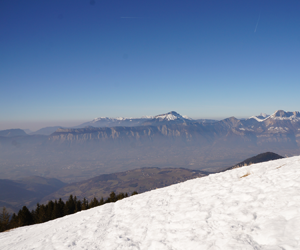Article contents
Mean flow structure of katabatic winds and turbulent mixing properties
Published online by Cambridge University Press: 25 April 2022
Abstract

The recent field measurements of katabatic winds on steep alpine slopes provide a unique database for theoretical analysis of the mean flow development and the determination of mixing properties. The theory is based on the depth-integrated momentum and heat equations, and demonstrates an increase in mean velocity  $U$ with downstream distance
$U$ with downstream distance  $x$ according to
$x$ according to  $x^{n}$ (
$x^{n}$ ( $n\leq 1/2$). An equation for the mean wind velocity is established, expressing its dependency on the buoyancy flux, related to the heat flux to the ground, entrainment and bottom friction. No ambient stratification, and ambient wind and constant ground surface temperature, lead to
$n\leq 1/2$). An equation for the mean wind velocity is established, expressing its dependency on the buoyancy flux, related to the heat flux to the ground, entrainment and bottom friction. No ambient stratification, and ambient wind and constant ground surface temperature, lead to  $U{\sim} x^{1/2}$, while constant heat flux to the ground leads to
$U{\sim} x^{1/2}$, while constant heat flux to the ground leads to  $U{\sim} x^{1/3}$ and requires that the reduced gravity decreases as
$U{\sim} x^{1/3}$ and requires that the reduced gravity decreases as  $x^{-1/3}$. Stable ambient stratification
$x^{-1/3}$. Stable ambient stratification  $N$ causes, in addition to small-amplitude mean flow oscillations, a decrease in reduced gravity with
$N$ causes, in addition to small-amplitude mean flow oscillations, a decrease in reduced gravity with  $x$, in which case the assumption of constant surface heat flux along
$x$, in which case the assumption of constant surface heat flux along  $x$ is only an approximation. The turbulent fluxes are a function of gradient Richardson number
$x$ is only an approximation. The turbulent fluxes are a function of gradient Richardson number  $Ri$ with the ratio of turbulent diffusivity to viscosity
$Ri$ with the ratio of turbulent diffusivity to viscosity  $K_h/K_m$ changing from nearly
$K_h/K_m$ changing from nearly  $1.4$ to approximately
$1.4$ to approximately  $0.5$ at
$0.5$ at  $Ri\approx 0.5$. A new mixing efficiency is introduced that includes turbulence kinetic energy production or consumption by along-slope turbulent buoyancy flux. It increases with
$Ri\approx 0.5$. A new mixing efficiency is introduced that includes turbulence kinetic energy production or consumption by along-slope turbulent buoyancy flux. It increases with  $Ri$ up to
$Ri$ up to  $0.25$ at
$0.25$ at  $Ri\approx 0.5$ and then remains nearly constant. The measurements allowed us to determine the bottom drag coefficients and interfacial entrainment, with the ground surface heat flux being determined from the mean buoyancy flux.
$Ri\approx 0.5$ and then remains nearly constant. The measurements allowed us to determine the bottom drag coefficients and interfacial entrainment, with the ground surface heat flux being determined from the mean buoyancy flux.
- Type
- JFM Papers
- Information
- Copyright
- © The Author(s), 2022. Published by Cambridge University Press
References
REFERENCES
- 3
- Cited by





